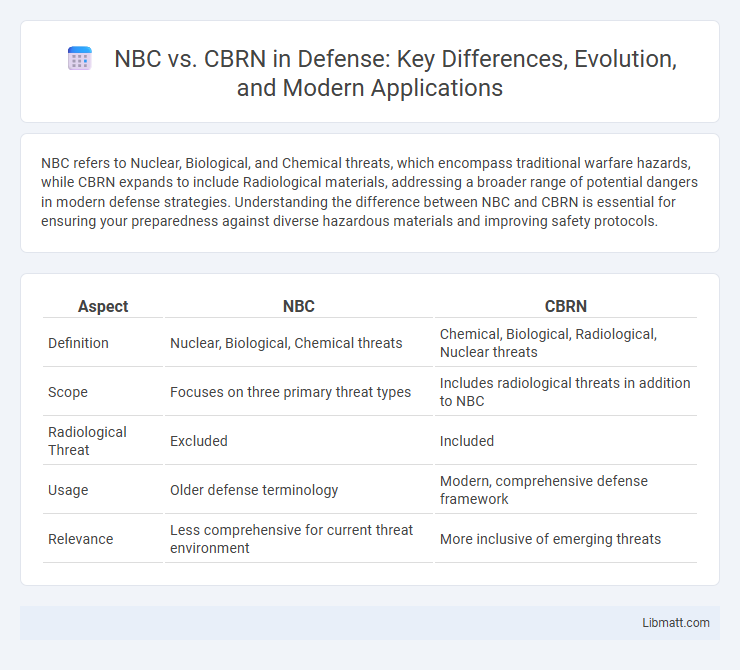NBC refers to Nuclear, Biological, and Chemical threats, which encompass traditional warfare hazards, while CBRN expands to include Radiological materials, addressing a broader range of potential dangers in modern defense strategies. Understanding the difference between NBC and CBRN is essential for ensuring your preparedness against diverse hazardous materials and improving safety protocols.
Table of Comparison
| Aspect | NBC | CBRN |
|---|---|---|
| Definition | Nuclear, Biological, Chemical threats | Chemical, Biological, Radiological, Nuclear threats |
| Scope | Focuses on three primary threat types | Includes radiological threats in addition to NBC |
| Radiological Threat | Excluded | Included |
| Usage | Older defense terminology | Modern, comprehensive defense framework |
| Relevance | Less comprehensive for current threat environment | More inclusive of emerging threats |
Understanding NBC and CBRN: Definitions and Differences
NBC (Nuclear, Biological, and Chemical) and CBRN (Chemical, Biological, Radiological, and Nuclear) represent critical categories of hazardous threats with distinct scopes. NBC traditionally excludes radiological hazards, focusing solely on nuclear, biological, and chemical agents, while CBRN incorporates radiological threats, reflecting a broader spectrum of potential dangers. Understanding these definitions clarifies the evolving nature of risk assessment and response strategies, helping you enhance preparedness and safety measures.
Historical Evolution: From NBC to CBRN
The transition from NBC (Nuclear, Biological, Chemical) to CBRN (Chemical, Biological, Radiological, Nuclear) reflects the historical evolution in threat assessment and defense strategies, integrating radiological hazards explicitly. This shift arose during the late 20th century as radiological threats, such as dirty bombs and radiological dispersal devices, gained prominence in military and civilian security planning. Modern CBRN defense frameworks prioritize comprehensive detection, protection, and decontamination measures addressing the full spectrum of chemical, biological, radiological, and nuclear risks.
Components Breakdown: Nuclear, Biological, Chemical, and Radiological Threats
NBC threats encompass Nuclear, Biological, and Chemical hazards, focusing on explosive and contaminant effects, while CBRN extends this framework by including Radiological dangers, highlighting the impact of radioactive materials dispersed intentionally or accidentally. Nuclear threats involve radiation and blast effects from atomic explosions; Biological threats refer to pathogens or toxins causing illness or death; Chemical threats include toxic substances designed to harm or incapacitate; Radiological threats concern the spread of radioactive particles without a nuclear detonation. Understanding the distinct components of CBRN enhances your preparedness by addressing a broader spectrum of hazardous agents beyond traditional NBC parameters.
Military Approaches: NBC vs CBRN in Defense Strategies
Military approaches to NBC (Nuclear, Biological, Chemical) and CBRN (Chemical, Biological, Radiological, Nuclear) defense strategies differ primarily in scope and threat response. NBC focuses on traditional nuclear, biological, and chemical hazards, while CBRN expands to include radiological threats, emphasizing detection, protection, and decontamination across a wider range of risks. Your defense strategy must integrate advanced CBRN technologies and training to effectively counter modern asymmetric warfare threats.
Civilian Preparedness: Emergency Planning for NBC and CBRN Events
Civilian preparedness for NBC (Nuclear, Biological, Chemical) and CBRN (Chemical, Biological, Radiological, Nuclear) events requires detailed emergency planning that addresses unique threats and response protocols. Incorporating robust detection systems, public education on sheltering and decontamination, and clear communication strategies enhances your readiness and minimizes casualties. Effective coordination between local agencies and first responders ensures rapid containment and recovery during these high-risk incidents.
Detection Technologies: Modern Tools for NBC and CBRN Threats
Advanced detection technologies for NBC (Nuclear, Biological, Chemical) and CBRN (Chemical, Biological, Radiological, Nuclear) threats incorporate sensor systems such as ion mobility spectrometers, mass spectrometers, and biosensors to identify hazardous agents rapidly and accurately. Innovations like drone-based sampling, real-time data analytics, and networked detection platforms enhance situational awareness and response capabilities in both military and civilian environments. These modern tools enable early warning, precise threat identification, and improved threat mitigation strategies critical for national security and public safety.
Protective Equipment: Comparing NBC and CBRN Gear
NBC protective equipment primarily guards against nuclear, biological, and chemical threats but lacks the advanced filtration and detection technologies found in CBRN gear. CBRN gear incorporates enhanced materials and integrated sensors to detect radiological and explosive hazards, offering broader and more precise protection. Your safety in hazardous environments improves significantly with CBRN equipment due to its comprehensive coverage and real-time threat identification.
International Regulations: Treaties and Compliance for NBC and CBRN
International regulations governing NBC (Nuclear, Biological, Chemical) and CBRN (Chemical, Biological, Radiological, Nuclear) threats include key treaties such as the Chemical Weapons Convention (CWC), Biological Weapons Convention (BWC), and the Treaty on the Non-Proliferation of Nuclear Weapons (NPT). Compliance with these treaties requires strict adherence to disarmament protocols, verification measures, and regular reporting to bodies like the Organisation for the Prohibition of Chemical Weapons (OPCW). Ensuring Your operations align with these international frameworks supports global security and legal accountability in managing NBC and CBRN hazards.
Training and Response: Adaptations from NBC to CBRN Protocols
Training and response protocols have evolved significantly from NBC (Nuclear, Biological, Chemical) to CBRN (Chemical, Biological, Radiological, Nuclear) frameworks to address emerging threats more comprehensively. CBRN training incorporates advanced detection technologies, enhanced decontamination procedures, and integrated emergency response strategies tailored to radiological hazards absent in NBC protocols. This shift ensures preparedness in diverse scenarios, optimizing first responder effectiveness and civilian safety in multifaceted CBRN incidents.
Future Trends: Emerging Risks and Innovations in NBC and CBRN Management
Emerging risks in NBC and CBRN management include the increased complexity of chemical, biological, radiological, and nuclear threats due to advancements in synthetic biology and cyber-physical attacks on critical infrastructure. Innovations such as AI-driven detection systems, wearable biosensors, and autonomous robotic decontamination platforms are being developed to enhance rapid response and situational awareness. Future trends emphasize integrated multi-hazard frameworks that combine real-time data analytics with advanced protective equipment to mitigate evolving NBC and CBRN threats effectively.
NBC vs CBRN Infographic

 libmatt.com
libmatt.com